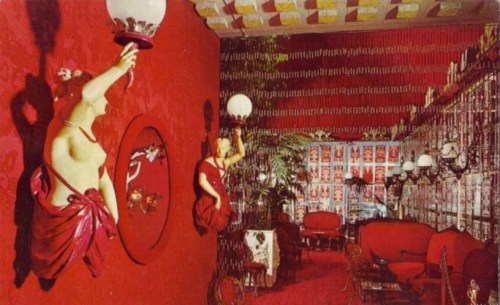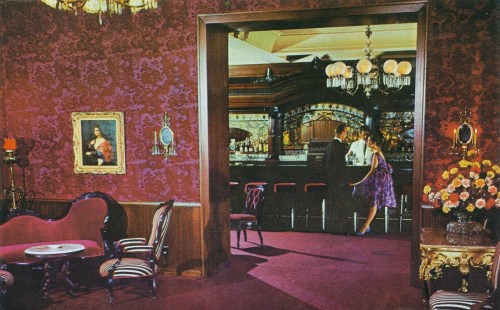In the 1960s turn-of-the-century brothels inspired restaurant decor, even in some places pitching to the family trade.
 Isn’t it strange that some restaurants with this type of decoration were meant to represent family good times? Mom and dad and the kids, for instance, eating burgers and fries while enjoying the songs of Lusty Lil and company at The Red Garter Saloon in a Shakopee MN amusement park. All in good fun of course, as if business in that venerable trade had been suspended long ago.
Isn’t it strange that some restaurants with this type of decoration were meant to represent family good times? Mom and dad and the kids, for instance, eating burgers and fries while enjoying the songs of Lusty Lil and company at The Red Garter Saloon in a Shakopee MN amusement park. All in good fun of course, as if business in that venerable trade had been suspended long ago.
In the 19th century and the early 20th, the connection between certain restaurants and “the oldest profession” was a well-known fact and provided at least one reason why women who valued their reputations tended to be fearfully shy of night life. As late as 1923, guardian of manners Emily Post wrote, “It is not good form for an engaged couple to dine together in a restaurant, but it is all right for them to lunch, or have afternoon tea.” If they drove to the countryside for a meal, she recommended they be accompanied by a chaperone.
In 1881 The National Police Gazette, a sensational men’s tabloid, warned of Italian restaurants. “Ostensibly kept for the purposes of dealing out the culinary requirements of the inner man, they depend upon the sporting element for patronage, and in the lowest den in the vilest neighborhood, to the first-class restaurant in the heart of the business section of the city, the bawd and her ‘man’ may be seen.”
In 1907 a number of popular restaurants in San Francisco were named as participants in a scheme in which politicians, for a fee, made sure the police did not interrupt the non-food side of their business. Among these restaurants were both the Old Poodle Dog and the grandiose New Poodle Dog.
 But by the early 1960s, the ambience of a brothel was considered not only proper but elegant, particularly for steakhouses. The hallmark of this decor had become red or red and black flocked wallpaper and lamps that looked like gas lights. There were various degrees of formality attaching to this theme, depending on whether it was interpreted as a “Wild West” dance hall or a “Gay 90s” Victorian parlor-style brothel. Another hallmark sneeringly remarked upon by critics was the overlarge pepper grinder, shown above standing erectly on a tray. Rather surprisingly, some respected restaurants such as Ernie’s in San Francisco adopted red-flocked decor [shown below].
But by the early 1960s, the ambience of a brothel was considered not only proper but elegant, particularly for steakhouses. The hallmark of this decor had become red or red and black flocked wallpaper and lamps that looked like gas lights. There were various degrees of formality attaching to this theme, depending on whether it was interpreted as a “Wild West” dance hall or a “Gay 90s” Victorian parlor-style brothel. Another hallmark sneeringly remarked upon by critics was the overlarge pepper grinder, shown above standing erectly on a tray. Rather surprisingly, some respected restaurants such as Ernie’s in San Francisco adopted red-flocked decor [shown below].
 Guess what happened when an actual “professional” of the trade opened a restaurant? Sally Stanford, as she was known professionally, had run a famed house of ill repute in San Francisco. When she retired in 1950 she opened a restaurant named Valhalla in Sausalito CA. From the start she was hassled by officials. First the police painted the street red in front of her restaurant, claiming it was to indicate a no-parking zone. Then, for several years the California Department of Alcoholic Beverage Control tried to take away her liquor license because she was a person of bad character. She fought back and eventually won and was declared rehabilitated. After many tries she was elected to the Sausalito city council in 1972, becoming mayor in 1976.
Guess what happened when an actual “professional” of the trade opened a restaurant? Sally Stanford, as she was known professionally, had run a famed house of ill repute in San Francisco. When she retired in 1950 she opened a restaurant named Valhalla in Sausalito CA. From the start she was hassled by officials. First the police painted the street red in front of her restaurant, claiming it was to indicate a no-parking zone. Then, for several years the California Department of Alcoholic Beverage Control tried to take away her liquor license because she was a person of bad character. She fought back and eventually won and was declared rehabilitated. After many tries she was elected to the Sausalito city council in 1972, becoming mayor in 1976.
In 1977 it was revealed that the CIA had created a brothel in San Francisco to test “truth serums” on unwary men they recruited in bars. They gave them $100 and took them to the brothel where the prostitutes working there (perhaps unknowingly) supplied them with drinks that had been laced with psychoactive drugs, possibly LSD. The brothel was decorated with stereotyped red and black decor. When interviewed about the CIA’s decorating scheme by a reporter, Sally criticized their taste, saying, “That’s about the scope of their minds. . . . I’m surprised the tricks weren’t suspicious once they walked into a place that looked like that.”
Sally died in 1982 and Valhalla closed a couple of years later, but hackneyed brothel decor can still be found in restaurants today. It has become an American classic.
© Jan Whitaker, 2019














 It's great to hear from readers and I take time to answer queries. I can't always find what you are looking for, but I do appreciate getting thank yous no matter what the outcome.
It's great to hear from readers and I take time to answer queries. I can't always find what you are looking for, but I do appreciate getting thank yous no matter what the outcome.



Pingback: Themes: bordellos | Restaurant-ing through history – Additional survival tricks
I was GM of the N Y Gaslight Club from 1976–78 and the club was a wonderful, very slightly shabby, elegant private club. The president of Gaslight, Bob Fredericks, hired a woman, Lynn (last name left out to protect the guilty if she is still extant) to redecorate and it was a total disaster. Anything but Gaslight style. Her re-do was disgusting. The place, when she finished, looked like a cheap–not even a fancy–whorehouse. That was one of the reasons I left the club to return to Miami, where the late, great, Lloyd Apple and I become–for five years–the catering directors at Epicure Market, that once-wonderful place also now gone.
Amazing — had a cuppa this AM & read the Post. Wow,just goes to show that “SEX” has played a Major Role in Humans lifestyle — including Restaurant-ing — since like Fa-Ever. This could be the origins of why the Me-Too Movement has come to fruition TODAY! The CIA involvement in 1977 was shocking but I was not surprised. What was shocking…Italian Restaurants “dealing out culinary requirements of the inner man” — I just😁😬WOW! Very informative. I will never look at the color RED in the same way again….a color of which I love — smh.
Once again a fascinating look at the history of eating out. And are those horrible monstrous pepper grinders we see everywhere a continuation of bordello-restaurant culture?
They had a separate history but do manage to fit in with bordello culture so very well.
Tad’s Steaks
Alfred Hitchcock beautifully recreated Ernie’s on a Hollywood soundstage in his 1958 classic “Vertigo”. Here is a clip: https://www.youtube.com/watch?v=cJxM5rG82aA